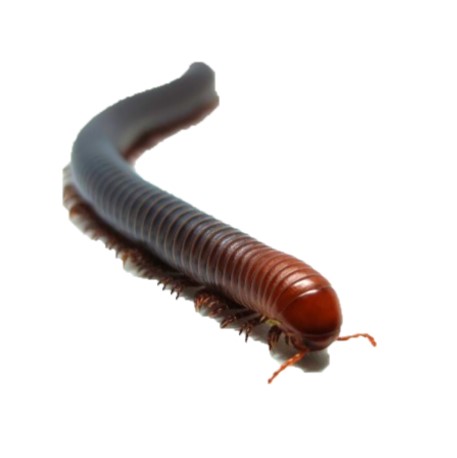Spirostreptus servatius – Firehead Millipede
£7.99 Inc. VAT
Out of stock
Receive an email when we get more stock
Spirostreptus servatius is a large species from West and Central Africa. Most of the animals grow up to 20 cm long, but specimens that are 26 cm long have also been sighted, although these are the exception. It is not known how old this species can become in nature. What is certain, however, is that it can live for over 5 years in the terrarium with good care. Their natural habitat is moist, shady forests. Sometimes they can be found under the name of firewood millipedes, or orange-headed millipedes. It happens that they are confused with Sechelleptus pyrhozonus. However, the difference can be seen relatively early on. Where Sechelleptus pyrhozonus shows an orange-grey ringing quite early, Spirostreptus servatius completely lacks it.
The slender body of Spirostreptus servatius is dull and grey-brown in colour. Legs and antennae are also in this color. The head of S. servatius is strikingly colored orange-red. The sexes of this species can be distinguished by coloration. Males are significantly duller in color than the females. In addition, their 7th segment is somewhat thickened.
Spirostreptus servatius should be kept from a base area of 30 cm x 60 cm. The substrate should be sprinkled about 15 cm high. Since this species creates extensive tunnel systems, it is better to offer more substrate than too little. The animals can often be observed on the surface during the day and do not have high demands on keeping, which makes them good “beginner animals”. They feel most comfortable at a temperature of around 25-28°C. The humidity should be between 70% and 80%. In order to be able to keep the humidity in your tank easier, it is advisable to lay out leaves, pieces of bark and moss on the substrate, this protects the substrate from drying out too quickly. Since the animals also like to climb, there should be branches in the terrarium. Handling the animals is uncomplicated, but you often read that they like to pinch. Only a few have succeeded in breeding this species. What motivates the animals to lay eggs has not yet been fully clarified. The animals may need a drying phase. The main part of their food is the organic material contained in the substrate, but additional food in the form of vegetables, fruit and millipede food is also popular.
Essential Husbandry info:
Temperature: 25 to 28c
Climate: Tropical
Diet: Rotting leaves, rotting wood, lichens
Breeding: Easy
Overall Diffiuclty: Easy
| Weight | 0.099 kg |
|---|---|
| Amount | 1, 5 |
Only logged in customers who have purchased this product may leave a review.
Related products
Millipedes
Millipedes






Reviews
There are no reviews yet.